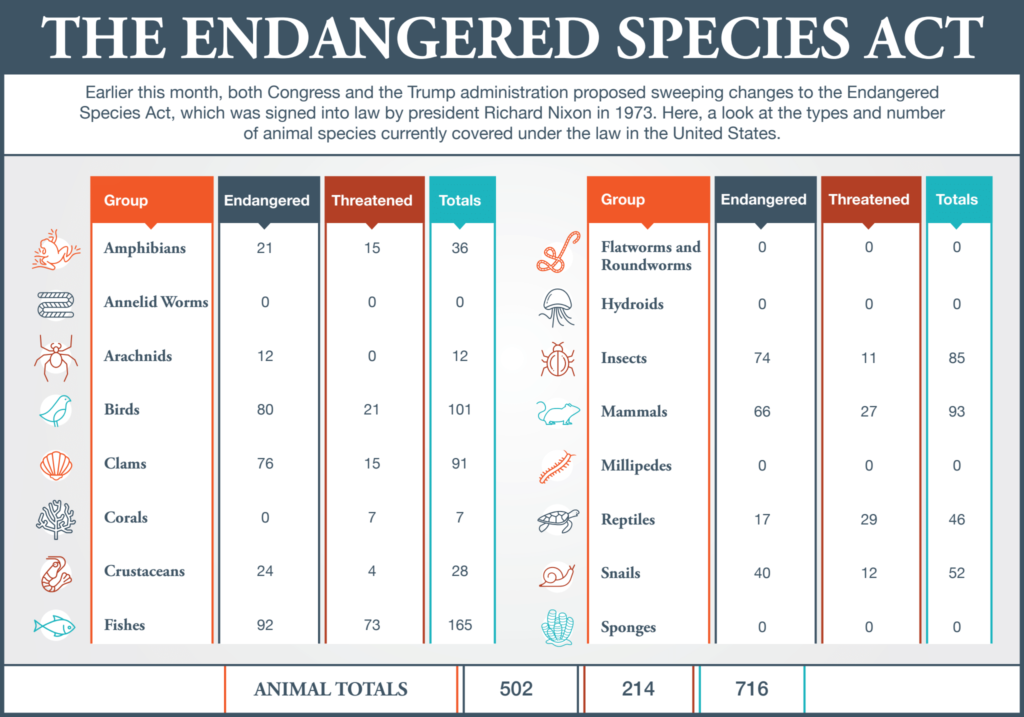

The U.S. Fish and Wildlife Service and National Oceanic Atmospheric Administration Fisheries on Wednesday published in the Federal Register a suite of proposed rule changes to the Endangered Species Act that would change how species make their way onto the list and take a species’ economic impact into account. The rule change process begins with a 60-day comment period on what would be some of the most significant alterations to the wildlife protection law since it was signed by president Richard Nixon in 1973.
Earlier this month, several members of Congress also introduced multiple bills to permanently alter the law through the legislative process; the approximately nine proposals include a notable overhaul draft supported by the Western Governors’ Association penned by Sen. John Barrasso, a Republican from Wyoming.
Those who engage most with the ESA — regulatory attorneys, environmental activists, oil and gas operators — at least for the time being seem more focused on the proposed rule changes by Fish and Wildlife and NOAA, the two federal agencies tasked with implementing the law, rather than those proposed by Congress.
“If I had limited resources, I would focus my efforts on these regulatory proposals,” said Holland & Hart partner Murray Feldman, who specializes in environmental litigation often involving the ESA. “Just based on past history, that’s the most likely area where something might happen.”
After the 60-day public comment period ends, the agencies could then amend the proposed rule changes or move forward with what’s already been drafted. “We are proposing these improvements to produce the best conservation results for the species while reducing the regulatory burden on the American people,” said U.S. Fish and Wildlife Service Principal Deputy Director Greg Sheehan in a prepared statement. “We value public input and have already incorporated initial public comments we received in response to our notices of intent published in 2017. We encourage the public to provide us additional feedback to help us finalize these rules.”
‘FORESEEABLE FUTURE’
One of the proposed changes that first struck Rebecca Almon, a director at Ireland Stapleton Pryor & Pascoe and chair of the firm’s environmental practice group, was language that would define the phrase “foreseeable future” in section 4 of the ESA.
Currently, the ESA states that “In determining whether a species is a threatened species, the Services must analyze whether the species is likely to become an endangered species within the foreseeable future.” The proposed change would define foreseeable future as extending “only so far into the future as the Services can reasonably determine that the conditions potentially posing a danger of extinction in the foreseeable future are probable.”
Although it may seem like a somewhat innocuous addition, Almon said critics believe this change is aimed at limiting consideration of climate change on future ESA listings. “It’s very difficult to predict the foreseeable future of the impact of climate change on a species,” Almon said.
Feldman described the section 4 change as the government formally adopting a definition that had already been in use. “Largely, they’re just codifying what the service has been using for the past 10 years,” he said. “The courts said the foreseeable future can be determined on a case-by-case basis.” Indeed, the change would adopt that language by adding “The Services will describe the foreseeable future on a case-by-case basis, using the best available data and taking into account consideration such as the species’ life-history characteristics, threat projection timeframes, and environmental variability.”
ENDANGERED VS. THREATENED
Kathleen Schroder, partner in the natural resources department at Davis Graham & Stubbs, described the proposed rule changes as including “a fair number of technical changes.” One such adjustment involves the way a “threatened” species would be managed.
There are two big-picture categories a species can be listed as under the ESA — endangered and threatened. The way the act is written right now, all the protections that the ESA affords an endangered species also automatically default to a threatened species. The proposed change would remove that default application. It reads, in part: “Among other changes, the proposal would add language in both sections to paragraph (a) to specify that its provisions apply only to species listed as threatened species on or before the effective date of this rule. Species listed or reclassified as a threatened species after the effective date of this rule, if finalized, would have protective regulations only if the Service promulgates a species-specific rule (also referred to as a special rule).”
“That’s how the National Marine Fisheries Service has it set up,” Schroder said. “It should be interesting; it may force the service to think more creatively about what kind protection threatened species warrant rather than just relying on the default.”
Feldman said the interpretation that allowed threatened species to have the same protections as endangered species dates back to 1978. “The idea being, you shouldn’t have to wait until the species gets into the emergency room,” Feldman said. “Now, in a somewhat sweeping revision to what’s been the status quo for two decades or more, the Fish and Wildlife Service is saying we’re going to go the other way.”

FOLLOWING THE MONEY
Almon highlighted a proposed change that would allow the government to consider the potential economic impact of listing a species as threatened or endangered, something that was previously not permitted under the ESA. “Originally, as the statute was drafted, a decision to list needed to be based on the best scientific evidence without reference to economic or possible impact,” she said.
This portion of the proposal would remove the phrase, “without reference to possible economic or other impacts of such determination,” from section 424.11 of the ESA, allowing the government to look at the financial implications in addition to biological conditions when determining whether to list a species.
“I think it’ll be easy to get a deer in the headlights look and be blindsided by cost and numbers,” Almon said. “Unfortunately, we can’t come up with those same numbers for maintaining this critical habitat.” Almon noted that without ESA protections that were put in place decades ago the bald eagle might very well have died off. “Ironically, that’s the symbol of the U.S.,” she said. “How do you put a price on that?”
UNOCCUPIED AREAS
One other proposed change of note, according to Feldman, is a shift in the way critical habitat for an endangered species would be designated, in particular making it more challenging to designate “unoccupied” habitat as critical. The proposal would flip back a rule implemented toward the end of the Obama administration.
In 2016, the agency removed the following language from the ESA: “The Secretary shall designate as critical habitat outside the geographical area presently occupied by a species only when a designation limited to its present range would be inadequate to ensure the conservation of the species.” Now, “the Services propose to revise section 424.12(b)(2) by restoring the requirement that the Secretary will first evaluate areas occupied by the species.”
“The Obama definition had suggested that a habitat that is unsuitable could develop into suitable in the future if it were cleaned up and met water quality standards could provide potential critical habitat,” Feldman said. “The Obama administration said you could designate that today and the new rule is taking back that language.”
Sept. 24 will mark the end of the agency’s comment period. In the meantime, there’s a plenty for stakeholders on all sides of the ESA to consider. As Feldman put it, “It’s like George Will used to say about baseball, ‘There’s a lot going on out there.’”
— Chris Outcalt

